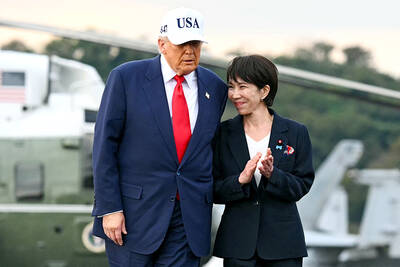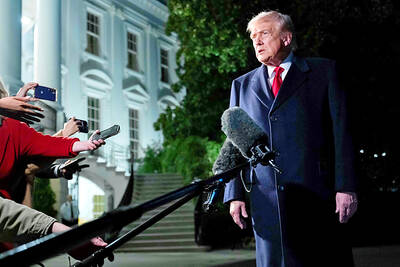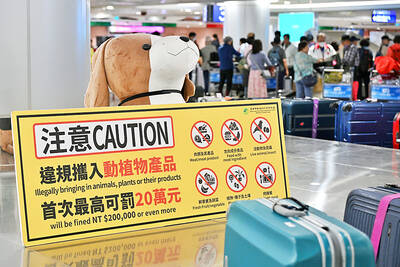A top US Navy admiral wants the powerful Third Fleet to expand its engagement in the Western Pacific from its headquarters in San Diego, California, by operating more closely with the Japan-based Seventh Fleet to focus on areas with the “greatest instability.”
In two recent speeches that received little media attention, US Pacific Fleet commander Admiral Scott Swift questioned the need for an administrative boundary running along the international date line to demarcate operations for the Seventh Fleet in the Western Pacific and the Third Fleet to the east.
In an early sign of a shift in strategy, US naval officials said Third Fleet commander Vice Admiral Nora Tyson rather than her Seventh Fleet counterpart would represent the US Navy at the Japanese fleet review on Oct. 18, a display of Japanese naval power held every three years.
“I would not be surprised to see more of Vice Admiral Tyson operating forward as part of this concept development process,” Swift said in a speech on Sept. 7 during a visit to Seventh Fleet headquarters in Yokosuka, Japan.
Any change would not mean the relocation of headquarters or home ports, but would allow the two fleets to work together in “areas with the greatest instability,” Swift said, without elaborating.
His remarks coincide with growing tension over China’s territorial ambitions in Asia’s disputed waters, especially in the South China Sea, where Beijing is building several artificial islands that include three airstrips.
Swift was away from his headquarters in Hawaii and not immediately available to comment, his office said.
A US Pacific Fleet naval official told reporters the idea was to scrap the administrative boundary, but that it was at the conceptual stage. He said the plan revolved around the Third Fleet “operating forward,” which is naval terminology for conducting patrols and missions in distant theaters.
It would formalize and expand the Third Fleet’s role in the Western Pacific from a command and control perspective, the official said on condition of anonymity, because he was not authorized to speak to the media.
“We’re not sure how often or when that would manifest at this point,” he added.
When operating west of the international date line, Third Fleet’s vessels have typically come under Seventh Fleet command, US naval officials said.
They said closer integration between the two fleets was separate from US President Barack Obama’s “pivot” to Asia, which is to see 60 percent of the US Navy’s assets deployed in the Pacific by 2020.
Washington-based Center for a New American Security Asia security expert Mira Rapp-Hooper cautioned against reading too much into the move.
“The Third Fleet may become more present symbolically in the Asia-Pacific [region], but I am not sure that this has major strategic implications, say for the US-Japan relationship ... at least based on what I understand thus far,” Rapp-Hooper said.
The Seventh Fleet has the US’ only forward deployed aircraft carrier strike group, along with 80 other vessels, 140 aircraft and 40,000 sailors.
The Third Fleet has more than 100 vessels, including four aircraft carriers. It was formed in 1943 under the command of US Navy fleet admiral William Halsey to fight the Imperial Japanese Navy in World War II. Japanese officials officially surrendered aboard its then flagship, the USS Missouri, just over 70 years ago.
In a speech on July 24 at Third Fleet headquarters in San Diego, Swift drew on that history.
“It is my intent to underscore the legacy of fleet admiral Halsey ... by enabling Vice Admiral Tyson to more fully employ her fleet forward,” he said. “I question why we are so allegiant to the international date line as a line of demarcation between the two most powerful numbered fleets in the world.”
Swift’s drive to integrate their operations comes as Japan pulls back from seven decades of state pacifism with the passage this month of legislation that will allow its navy to work more closely with its US counterpart.
A key feature of the new laws is an end to a ban on exercising the right of collective self-defense, or defending the US or another friendly country that comes under attack in cases where Japan faces a “threat to its survival.”
Extending the Third Fleet’s command to Asia would likely mean tighter cooperation between US naval commanders based in the Eastern Pacific and Japanese naval officers, who already work closely with the Seventh Fleet, the US Pacific Fleet naval official said.

UKRAINE, NVIDIA: The US leader said the subject of Russia’s war had come up ‘very strongly,’ while Jenson Huang was hoping that the conversation was good Chinese President Xi Jinping (習近平) and US President Donald Trump had differing takes following their meeting in Busan, South Korea, yesterday. Xi said that the two sides should complete follow-up work as soon as possible to deliver tangible results that would provide “peace of mind” to China, the US and the rest of the world, while Trump hailed the “great success” of the talks. The two discussed trade, including a deal to reduce tariffs slapped on China for its role in the fentanyl trade, as well as cooperation in ending the war in Ukraine, among other issues, but they did not mention

Japanese Prime Minister Sanae Takaichi yesterday lavished US President Donald Trump with praise and vows of a “golden age” of ties on his visit to Tokyo, before inking a deal with Washington aimed at securing critical minerals. Takaichi — Japan’s first female prime minister — pulled out all the stops for Trump in her opening test on the international stage and even announced that she would nominate him for a Nobel Peace Prize, the White House said. Trump has become increasingly focused on the Nobel since his return to power in January and claims to have ended several conflicts around the world,

REASSURANCE: The US said Taiwan’s interests would not be harmed during the talk and that it remains steadfast in its support for the nation, the foreign minister said US President Donald Trump on Friday said he would bring up Taiwan with Chinese President Xi Jinping (習近平) during a meeting on the sidelines of the APEC Summit in South Korea this week. “I will be talking about Taiwan [with Xi],” Trump told reporters before he departed for his trip to Asia, adding that he had “a lot of respect for Taiwan.” “We have a lot to talk about with President Xi, and he has a lot to talk about with us. I think we’ll have a good meeting,” Trump said. Taiwan has long been a contentious issue between the US and China.

Taiwan’s first African swine fever (ASF) case has been confirmed and would soon be reported to the World Organization for Animal Health (WOAH), Minister of Agriculture Chen Junne-jih (陳駿季) yesterday. The Ministry of Agriculture’s Veterinary Research Institute yesterday completed the analysis of samples collected on Tuesday from dead pigs at a hog farm in Taichung and found they were ASF-positive. Animal and Plant Health Inspection Agency Animal Quarantine Division chief Lin Nien-nung (林念農) said the result would be reported to the WOAH and Taiwan’s major trade partners would also be notified, adding that pork exports would be suspended. As of Friday, all samples